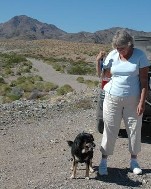Reading Rocks and Minerals of California by Vinson Brown, et al. This is a book from Riverside County Library, so I thought I would save my notes here.
Anywhere where there are hills or mountains or stream beds you are likely to make surprising discoveries. Look always for fresh exposures of rock layers, such as road cuts, stream cuts, places where landslides have occurred, quarries and localitites where there has been volcanic action.
This book has many maps of sites throughout the state of California, and some in San Bernardino and Riverside county. However, there are none in the immediate area of Needles. The author has organized the whole book according to keys in order to make the identification of rocks and minerals easier. Here's how it works.
1. You notice where on the map your mineral was found. It is likely to be one of the minerals shown as being found in that part of the country. (I'll scan in the maps for SB and Riverside counties, maybe Inyo/Mono, too.)
2. You notice what kind of a habitat or environment it was found in, whether in a limestone quarry, an ore vein, a stream bed, and so on. Only certain kinds of minerals are found in each mineral habitat. (This is sort of where I was headed, by separating our field trips into different kinds of environments, and then getting up close and personal with those sites.)
3. Then you use the general rock key or the general mineral key to narrow down the identification even more.
4. You ask Corinne.
The author then discusses the Genearal Mineral Key first. Minerals are the building blocks of rocks. If you learn about them first, you are on your way to identify the rocks of which they are components.
To identify minerals you must test them.
Physical Tests
Hardness
Hardness is very important in identifying minerals, as they differ greatly in hardness. Ten different minerals have been chosen to use, from 1 (soft) to 10 (extremely hard). They are:
1 - Talc
2 - Gypsum
3 - Calcite
4 - Fluorite
5 - Apatite
6 - Feldspar (Orthoclase)
7 - Quartz
8 - Topaz
9 - Corundum
10 - Diamond
There are four common objects, available anywhere, that we can use for judging hardness. These are a fingernail, with a hardness of 2.5, a copper coin, with a hardness of 3, a knife blade, with a hardness of 5.5, and a piece of sharp quartz, with a hardness of 7. Have these tools in your kit. They will be useful in using the author's keys.
Streak
The color of a powdered mineral may be different than its apparent color. This streak is obtained by rubbing the mineral on a piece of unglazed porcelian.
Color
Most minerals have so many different colors that this is not a good physical test. However, certain metallic minerals have very distinctive colors. Unfortunately the metallic luster of these mineral appears poorly in color plates.
Luster
The reflection of light on the surface of a mineral gives it its luster. The big division is into metallic and non-metallic luster in minerals. Non-metallic lusters include vitreous (glassy), pearly, adamantine (diamond sparkling), resinous (like resin in a tree), silky and greasy.
Cleavage
Most minerals have a tendency to break in certain definite directions. This is called cleavage. The more or less smooth surfaces left are called the cleavage planes, which are always planes of the crystal structure and thus are parallel to the possible crystal faces. The exact angle and type of cleavage is often important in identification. So far as possible these cleavage are illustrated in the key (see index also).
Examples:
Octahedral
Cubic
Rhombic
Orthorhombic
Fracture
If a mineral breaks irregularly rather in smooth planes, it is said to fracture. See illustration for kinds of fracture.
Types:
hackly
uneven
even
conchoidal
Specific gravity (sp. gr.) is the weight of a mineral compared to the weight of an equal volume of water. To find the specific gravity of a mineral, get a pure specimen and weigh it as shown, first in air and then in water. The specific gravity will be the weight in the air divided by the difference between the weight in the air and the weight in the water.
Crystal form
Most minerals have a definite crystal structure on which is based their outward appearance or form. So far as possible, in the illustrations of the minerals, we show their crystal form when it is useful in their identification. The index lists all the crystal forms shown in this book.
Chemical Tests
There are numerous complex chemical test for aid in identifying minerals, but most of these are too advanced for this book. Certain minerals, however, can be identified by simple chemical test, such as heating them in a gas flame or touching them with dilute hydrochloric acid to see if they will fizz. Whenever these simple tests are mentioned in the mineral key, use them.
I'm going to scan in the Key to Common California Minerals and print it out as a guide. Seems fairly straight-forward, but we'll see.
I'll keep you posted. :)
Saturday, April 01, 2006
Subscribe to:
Post Comments (Atom)






No comments:
Post a Comment